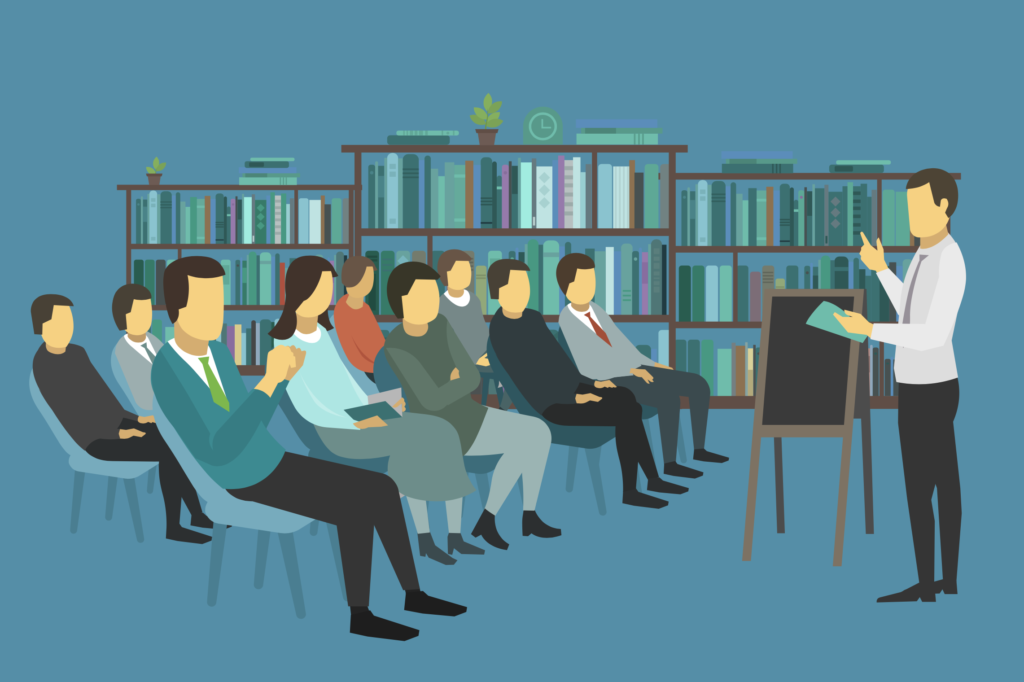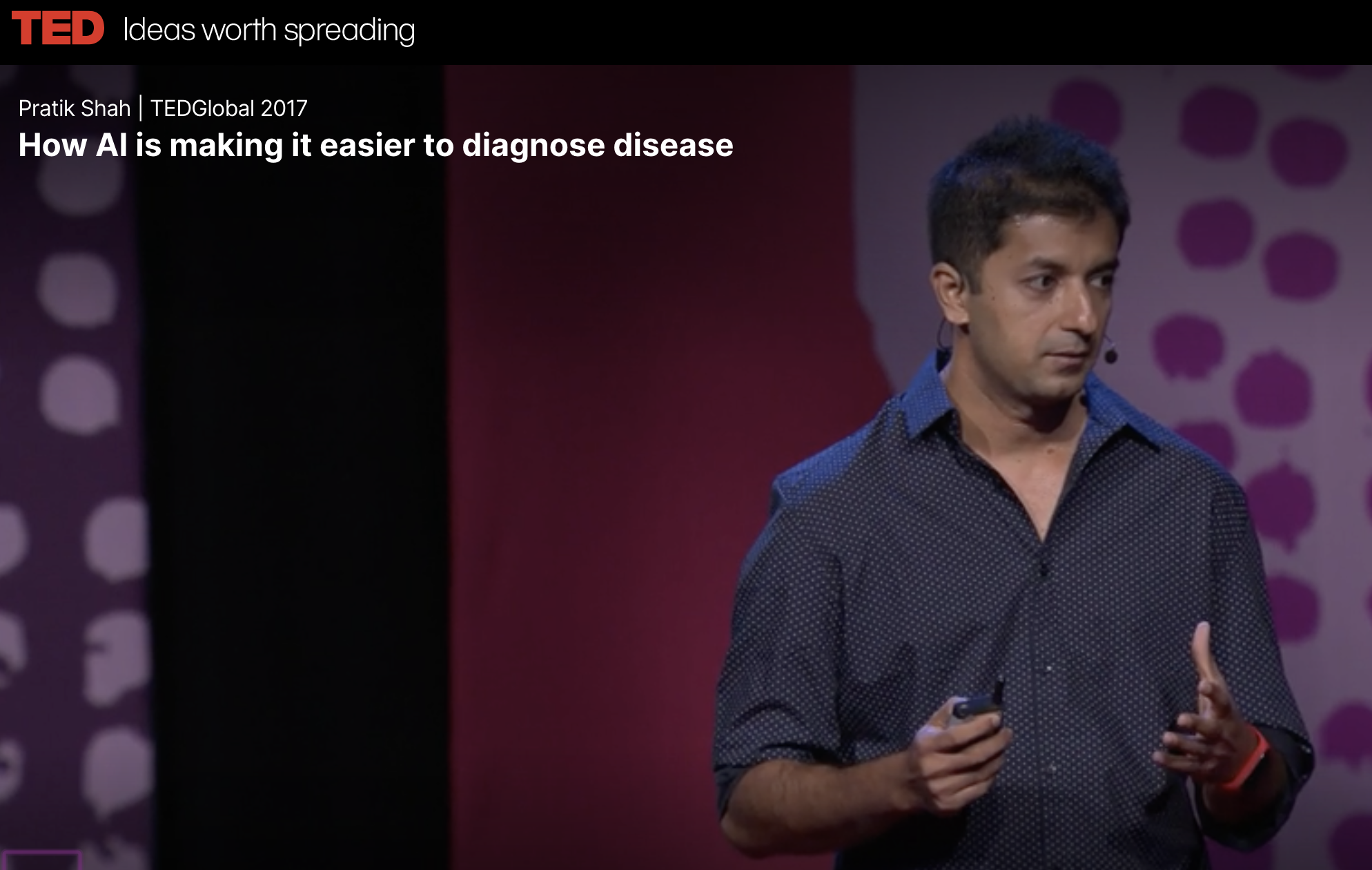こんにちは。
TEDの動画からビジネス系英語学習、特に医療英会話の学習に有用なスピーチを紹介します。
今回のテーマは医療×AIに関する内容です。
医療に携わる方も、AIに興味がある方も、非常に有用な内容でしたので、是非動画で学習していきましょう。
講演するのはプラティック・シャー先生です。
プラティック・シャー先生はMIT Media Labのリサーチサイエンティスト、主任研究員であり、AIを利用した画像診断システムの構築に取り組んでいる第一人者です。
講演の内容は「AIを利用して診断を如何に容易にする事が出来るのか。その方法について考える。」といった非常に興味深い内容です。
早速見ていきましょう。
TEDで医療英会話を学習【プラティック・シャー|AIが病気の診断を簡単にする方法】
英語-日本語訳全文
00:04
Computer algorithms today are performing incredible tasks with high accuracies, at a massive scale, using human-like intelligence.
現在のコンピューターアルゴリズムは 素晴らしい仕事をしており、人間のような知能を持ち 膨大なデータを 高い精度で処理しています。
And this intelligence of computers is often referred to as AI or artificial intelligence.
このコンピューターの知能は よく「AI」 あるいは「人工知能」と呼ばれます。
AI is poised to make an incredible impact on our lives in the future.
AIは 人々の将来の暮らしに 素晴らしい影響を及ぼそうとしています。
Today, however, we still face massive challenges in detecting and diagnosing several life-threatening illnesses, such as infectious diseases and cancer.
しかし私達は今でも、感染症やがんなどの命に関わる病気を発見や診断をする際に数多くの課題に直面しています。
Thousands of patients every year lose their lives due to liver and oral cancer.
毎年 何千人もの患者が 肝臓がんや口腔がんで 亡くなっています。
00:41
Our best way to help these patients is to perform early detection and diagnoses of these diseases.
これらの患者を救う 最善の方策は がんの早期発見と診断を 行うことです。
So how do we detect these diseases today, and can artificial intelligence help?
現在 病気はどう検出されているでしょう?AIは活用可能でしょうか?
In patients who, unfortunately, are suspected of these diseases, an expert physician first orders very expensive medical imaging technologies such as fluorescent imaging, CTs, MRIs, to be performed.
不幸にも患者にこれらの病気の疑いがある際には 専門医が最初に指示するのは 蛍光イメージング、CT、MRIなどのとても高価な 医用画像技術の使用です。
Once those images are collected, another expert physician then diagnoses those images and talks to the patient.
画像が集まったら また別の専門医が画像を診断し 患者に診断を告げます。
As you can see, this is a very resource-intensive process, requiring both expert physicians, expensive medical imaging technologies, and is not considered practical for the developing world.
お分かりのようにこの過程は 膨大なリソースを要します。2人の専門医、高価な医用画像技術 発展途上国では実用的ではありません。
And in fact, in many industrialized nations, as well.
実際は 多くの先進国でも同じです。
01:31
So, can we solve this problem using artificial intelligence?
ではAIを使って この問題を 解決できるでしょうか?
Today, if I were to use traditional artificial intelligence architectures to solve this problem, I would require 10,000 -- I repeat, on an order of 10,000 of these very expensive medical images first to be generated.
現在もし私が従来のAIの仕組みを使ってこの問題を解決しようとしたなら、1万枚もの― 繰り返しますが万単位のとても高価な医用画像が まず必要になります。
After that, I would then go to an expert physician, who would then analyze those images for me.
その後 私は専門医のところに行き、これらの画像を 分析してもらいます。
And using those two pieces of information, I can train a standard deep neural network or a deep learning network to provide patient's diagnosis.
そして これら2つの 情報を用いて、患者を診断するために 標準的な ディープニューラルネットワークまたはディープラーニングネットワークに 学習させることができます。
Similar to the first approach, traditional artificial intelligence approaches suffer from the same problem.
最初のアプローチと同じように AIを使った従来のアプローチでは 同じ問題に突き当たります。
Large amounts of data, expert physicians and expert medical imaging technologies.
膨大なデータ、専門医 専門医用画像技術などです。
02:11
So, can we invent more scalable, effective and more valuable artificial intelligence architectures to solve these very important problems facing us today?
ではより広めやすく、より効果的でより価値のある AIを構築し現在私達が直面する 重要な課題を解決することは可能でしょうか?
And this is exactly what my group at MIT Media Lab does.
それがまさに MITメディアラボで 私のグループが取り組んでいる内容です。
We have invented a variety of unorthodox AI architectures to solve some of the most important challenges facing us today in medical imaging and clinical trials.
現在 医用画像や臨床試験で直面する、最も重要な課題のいくつかを解決するために いくつかの斬新な AIの仕組みを開発しました。
02:35
In the example I shared with you today, we had two goals.
今日皆さんにお伝えした例では2つの目標がありました。
Our first goal was to reduce the number of images required to train artificial intelligence algorithms.
最初の目標は AIのアルゴリズムの学習に必要な画像の枚数を減らすことでした。
Our second goal -- we were more ambitious, we wanted to reduce the use of expensive medical imaging technologies to screen patients. So how did we do it?
2つ目の目標は より野心的で、患者をスクリーニングする際の高価な医用画像技術の使用を減らしたいと考えました。私達は どう取り組んだでしょう?
02:54
For our first goal, instead of starting with tens and thousands of these very expensive medical images, like traditional AI, we started with a single medical image.
最初の目標については 従来のAIのように数万枚もの高価な医用画像から取りかかるのではなく1枚の医用画像から始めることにしました。
From this image, my team and I figured out a very clever way to extract billions of information packets.
私のチームは この画像から 何十億もの 情報パケットを抽出する 賢い方法を見つけました。
These information packets included colors, pixels, geometry and rendering of the disease on the medical image.
これら情報パケットに含まれるのは 色、画素、位置関係— そして医用画像に 病巣をレンダリングしたものです。
In a sense, we converted one image into billions of training data points, massively reducing the amount of data needed for training.
ある意味 1枚の画像を何十億もの 学習用データへ変換できたことで 学習に必要なデータ量の 大幅減が可能になりました。
03:23
For our second goal, to reduce the use of expensive medical imaging technologies to screen patients, we started with a standard, white light photograph, acquired either from a DSLR camera or a mobile phone, for the patient.
二つ目の目標 スクリーニングの目的で 高価な医用画像検査の使用を減らすために、患者のためにデジタル一眼レフカメラや 携帯電話で撮影された 標準的な白色光の写真から始めました。
Then remember those billions of information packets?
先程の何十億もの 情報パケットを覚えていますか?
We overlaid those from the medical image onto this image, creating something that we call a composite image.
医用画像から得たそれらの情報をこの画像の上に重ね、いわゆる合成写真を作りました。
Much to our surprise, we only required 50 -- I repeat, only 50 -- of these composite images to train our algorithms to high efficiencies.
かなり驚いたことに わずか50枚で十分でした。繰り返しますが、わずか50枚の 合成写真で 効率よくアルゴリズムに 学習させることができました。
03:54
To summarize our approach, instead of using 10,000 very expensive medical images, we can now train the AI algorithms in an unorthodox way, using only 50 of these high-resolution, but standard photographs, acquired from DSLR cameras and mobile phones, and provide diagnosis.
私達のアプローチをまとめると、1万枚の とても高価な医用画像を 使うのではなく、AIアルゴリズムを画期的な 方法で学習させることが可能になりました。デジタル一眼レフカメラや 携帯電話で撮影した標準的な高解像度写真がたった50枚あれば 診断ができます。
More importantly, our algorithms can accept, in the future and even right now, some very simple, white light photographs from the patient, instead of expensive medical imaging technologies.
より重要なことに 私達のアルゴリズムは将来、そして今でも高価な医用画像技術ではなく患者が持つ ごくシンプルな白色光写真を 活用できます。
04:20
I believe that we are poised to enter an era where artificial intelligence is going to make an incredible impact on our future.
AIが私達の将来に 素晴らしい影響を及ぼす 時代に入ろうとしていると私は考えています。
And I think that thinking about traditional AI, which is data-rich but application-poor, we should also continue thinking about unorthodox artificial intelligence architectures, which can accept small amounts of data and solve some of the most important problems facing us today, especially in health care.
データはたくさんあれど 運用が不便だった従来のAIのことを考えると、特に医療分野において少量のデータを活用し、私達が現在直面する最も大切な課題を解決できる斬新なAIの仕組みについて引き続き考えていくべきです。
04:44-04:45
Thank you very much.
どうもありがとうございました。(Applause)
まとめ|今回のスピーチの内容
今回のスピーチの内容の要約です。
現在のAIアルゴリズムは、病気を検出するために何万枚もの高価な医用画像を必要とします。
もし、AIの学習に必要なデータの量を大幅に削減し、診断を安価で、より効果的なものにできるとしたらどの様なメリットがあるのかをプラティック・シャーは語っています。
斬新なAIのアプローチを用いて、シャーはアルゴリズムを構築するのに画像を50枚しか必要としない技術を開発しました。
また、医者の携帯電話で撮影した写真でも診断を可能にしました。
この医療情報分析の新しい方法がどのように、命に関わる病気の早期発見につながり、AIに支えられた診断が世界の医療の環境を提供できるのか講演しています。
医師としてもAIに携わる者としても、非常に勉強になる内容でした。

